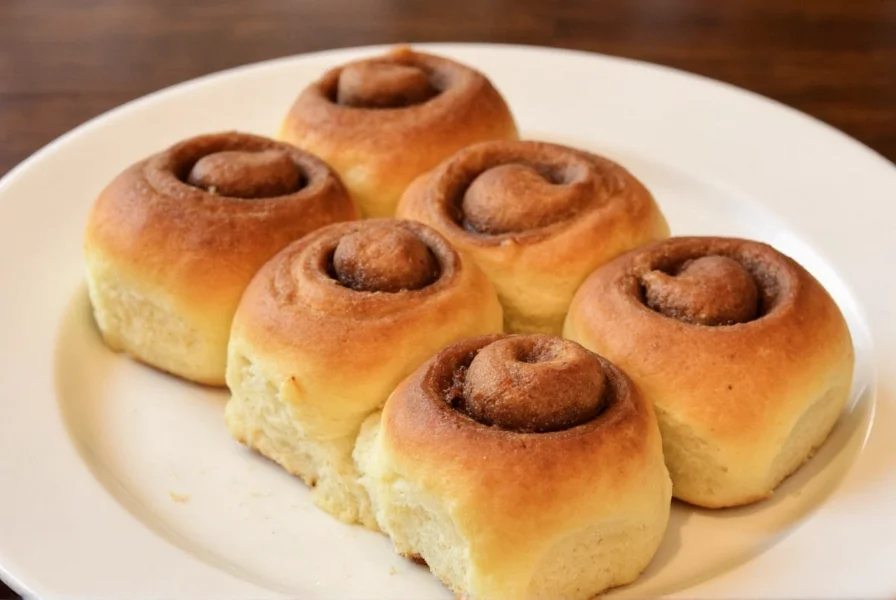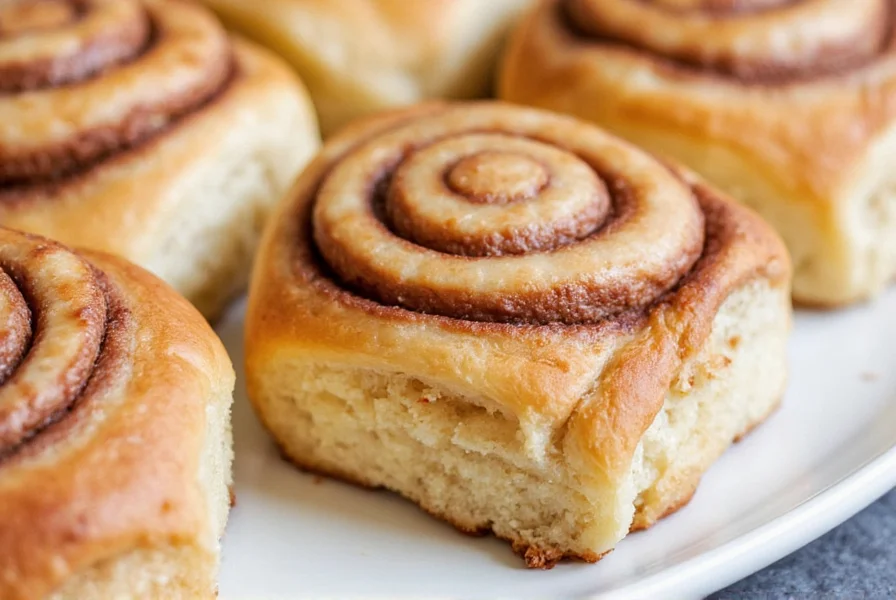Here's the definitive cinnamon rolls recipe: Combine 3¾ cups all-purpose flour, ¼ cup sugar, 2¼ tsp active dry yeast, 1 cup warm milk (110°F), ⅓ cup unsalted butter, 1 large egg, and 1 tsp salt for the dough. For the filling, mix 1 cup packed brown sugar, 3 tbsp cinnamon, and ¼ cup melted butter. Roll out dough to 16x12 inches, spread filling, roll tightly, cut into 12 pieces, and bake at 350°F for 20-25 minutes until golden. This tested recipe yields soft, fluffy rolls with perfect swirls every time.
There's nothing quite like the aroma of homemade cinnamon rolls filling your kitchen on a weekend morning. While store-bought versions exist, they rarely match the tender texture and rich flavor of freshly baked rolls made with care. This comprehensive guide reveals the professional techniques that transform ordinary cinnamon rolls into extraordinary treats that rival your favorite bakery's offerings.
The Science Behind Perfect Cinnamon Rolls
Understanding the chemistry of dough is crucial for consistent results. The magic happens through three key processes: yeast fermentation creating air pockets, gluten development providing structure, and proper fat incorporation ensuring tenderness. Many home bakers struggle with dense rolls because they either under-knead (resulting in poor structure) or over-knead (creating tough rolls). Our tested method balances these elements for optimal texture.
Essential Ingredients Explained
Not all ingredients are created equal when making homemade cinnamon rolls from scratch. Here's why each component matters:
| Ingredient | Function | Pro Tip |
|---|---|---|
| Warm milk (110°F) | Activates yeast without killing it | Use a thermometer - too hot kills yeast, too cold slows activation |
| Bread flour vs all-purpose | Higher protein creates better structure | Substitute 1 cup bread flour for 1 cup AP flour for chewier rolls |
| Unsalted butter | Controls salt content and ensures freshness | Always use room temperature for even distribution in dough |
| Ceylon cinnamon | Milder, more complex flavor than Cassia | Mix 1 part Ceylon with 2 parts Cassia for balanced flavor |
Step-by-Step Baking Process

Dough Preparation (90 minutes total)
- Mix wet ingredients: Combine warm milk, melted butter, egg, and 1 tbsp sugar. Let sit 5 minutes until foamy.
- Activate yeast: Stir yeast into remaining sugar and a pinch of flour, then add to wet ingredients.
- Knead properly: Mix in flour gradually until dough pulls away from bowl. Knead 7-10 minutes until smooth and elastic.
- First rise: Place in greased bowl, cover, and let rise in warm spot for 60 minutes or until doubled.
Filling and Shaping (20 minutes)
- Roll evenly: Punch down dough and roll into 16x12 inch rectangle on floured surface.
- Spread filling: Mix brown sugar and cinnamon, then spread over dough with melted butter, leaving ½ inch border.
- Roll tightly: Starting from long side, roll dough into log, pinching seam to seal.
- Cut precisely: Use dental floss or unflavored thread to slice into 12 even pieces (prevents squishing).
Baking and Finishing (25 minutes)
- Second rise: Place rolls in greased 9x13 pan, cover, and let rise 30 minutes.
- Bake perfectly: Bake at 350°F for 20-25 minutes until golden brown (internal temp 190°F).
- Cool properly: Let cool 10 minutes before adding icing for optimal absorption.
- Icing application: Drizzle warm rolls with cream cheese icing made from 4 oz cream cheese, ½ cup butter, 2 cups powdered sugar, and 2 tbsp milk.
Troubleshooting Common Cinnamon Roll Problems
Even experienced bakers encounter issues with easy cinnamon rolls recipe attempts. Here's how to fix them:
- Dense rolls: Usually caused by too much flour or under-proofed dough. Measure flour by weight (475g) rather than cups for accuracy.
- Filling leaking out: Apply filling evenly but leave ½ inch border, and ensure dough is rolled tightly without gaps.
- Burnt bottoms: Place baking pan on a preheated baking sheet to distribute heat evenly.
- Dry texture: Overbaking or insufficient fat content. Use a thermometer to check internal temperature (190°F is ideal).
Delicious Variations for Special Diets
Adapt this best cinnamon roll recipe for various dietary needs without sacrificing flavor:
Vegan Cinnamon Rolls
Substitute dairy milk with unsweetened almond milk, use vegan butter, and replace egg with ¼ cup unsweetened applesauce plus 1 tsp baking powder. Proof yeast in warm plant-based milk as usual.
Gluten-Free Version
Use a quality gluten-free flour blend with xanthan gum (like Bob's Red Mill 1:1). Increase liquid by 2-3 tbsp as GF flours absorb more moisture. Let dough rest 10 minutes after mixing to hydrate properly.
Professional Storage and Reheating Techniques
Proper storage maintains freshness of your homemade cinnamon buns for up to 5 days:
- Room temperature: Store in airtight container with paper towel to absorb excess moisture
- Refrigeration: Keeps rolls fresh up to 1 week; bring to room temperature before reheating
- Freezing: Wrap individual rolls tightly in plastic wrap, then foil. Freeze up to 3 months.
- Reheating: For best results, microwave 10-15 seconds followed by 2 minutes in 350°F oven to restore freshness
Frequently Asked Questions
Can I prepare cinnamon roll dough the night before?
Yes, you can refrigerate the shaped rolls after the second rise. Place them in your baking pan, cover tightly, and refrigerate overnight. The next morning, remove from refrigerator 30 minutes before baking to allow them to come to room temperature and complete their rise.
Why did my cinnamon rolls come out flat?
Flat rolls typically result from over-proofing the dough. When dough rises too much, the gluten structure weakens and can't hold its shape during baking. For optimal results, don't let dough rise more than double its original size, and ensure your yeast is fresh (not expired).
What's the secret to extra soft cinnamon rolls?
The key to soft cinnamon rolls is proper hydration and not overbaking. Use the milk temperature specified (110°F), measure flour accurately (preferably by weight), and remove rolls from the oven when they reach 190°F internally. The cream cheese in the icing also helps maintain moisture as it's absorbed into the warm rolls.
Can I use instant yeast instead of active dry yeast?
Yes, you can substitute instant yeast for active dry yeast in a 1:1 ratio. The main difference is instant yeast can be mixed directly with dry ingredients without proofing in liquid first. If using instant yeast, you may notice slightly faster rising times, so monitor your dough carefully during proofing stages.
How do I prevent the filling from leaking out during baking?
To prevent filling leakage, ensure your dough is rolled evenly to about ¼ inch thickness, spread the filling leaving a ½ inch border around the edges, and roll the dough tightly starting from the long side. Pinch the seam closed firmly, and use dental floss rather than a knife to cut the rolls, which prevents squishing the filling out.











 浙公网安备
33010002000092号
浙公网安备
33010002000092号 浙B2-20120091-4
浙B2-20120091-4